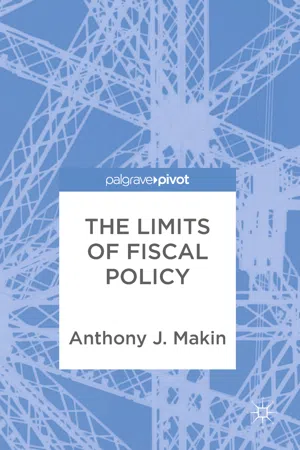1.1 Introduction
The role fiscal policy plays in influencing short-run macroeconomic behaviour has long been contentious and, since publication of John Maynard Keynes’ General Theory of Money, Interest and Employment (1936), academic consensus on the effectiveness of fiscal activism has oscillated.
The defining characteristic of Keynesianism is that governments can increase national output , and hence employment, by augmenting aggregate demand through budgetary policy , most notably by boosting government spending . Economies are presumed inherently unstable due to volatile private investment , and consumption spending is promoted over saving . These ideas can be found in almost all texts espousing macroeconomics principles.
Prior to the Global Financial Crisis Keynes’ influence on macroeconomic policy reached its zenith in the 70s, which was easily the single worst decade for economic performance in the OECD region since the Depression . That decade was characterised by Keynes’ legacy of high budget deficits and loose monetary policy which in turn contributed to persistently high inflation, stagnant stock markets and high unemployment .
Recognising this, former British Labour Prime Minister James Callaghan declared in 1977: ‘We used to think we could spend our way out of recession . I tell you, in all candour, that that option no longer exists, and that if it ever did exist, it only worked by injecting bigger doses of inflation into the economy followed by higher levels of unemployment as the next step. That is the history of the past 20 years.’
As 1974 Nobel laureate Friedrich Hayek commented: ‘This Keynesian doctrine has caused great harm and is responsible, to a great extent, for the problems the international economy has experienced in the seventies’ (quoted in Pizano 2009). Keynesianism was subsequently discredited in the 1980s and 1990s by Monetarist and New Classical economists and more Nobel prizes were awarded to non-Keynesians than to Keynesians over this time.
1.2 The G20 Fiscal Response to the Global Financial Crisis
Support for fiscal activism had largely waned from the 1970s onwards, but at the insistence of the US Obama Administration and the International Monetary Fund was suddenly revived worldwide in response to the Global Financial Crisis . This set a new precedent for internationally co-ordinated fiscal activism in response to future financial crises. 1
In hindsight, Global Financial Crisis seems a misnomer, however, since many emerging economies, including China , did not experience recession and recovered quickly from the initial downturn. The comparable geo-financial 1997–1998 Asian banking and currency crisis (the ‘Asian crisis’) did not prompt a globally co-ordinated fiscal response, and had only short-term international repercussions for macroeconomic activity, unlike the more aptly named transatlantic financial crisis of 2008–2010. By relying mainly on rapid monetary responses, non-Asian economies coped well during that crisis.
In an early 2009 open letter to President Obama published in leading US newspapers, hundreds of US academic economists, including Nobel laureates James Buchanan and Edward Prescott , endorsed a statement 2 that more government spending was not the way to improve US economic performance. Believing otherwise, they said, was ‘a triumph of hope over experience’. John Taylor (2009b) and Vito Tanzi (2013) also highlighted the role of government and underlying structural problems that precipitated and worsened the crisis.
Motivated by fears of a repeat of the Depression of the 1930s, the revival of fiscal activism in response to the global financial (or transatlantic) crisis was justified by Keynes’ Depression economics. Though dormant as an influence on macroeconomic policy for years leading up to the crisis, Keynesianism unexpectedly reappeared centre stage as the sole theoretical rationale for fiscal stimulus . Yet, as the above-mentioned group of US economists asserted that: ‘More government spending by Hoover and Roosevelt did not pull the US economy out of the Great Depression .’
Even though the effectiveness of discretionary fiscal policy in stabilising economies over the medium term had not been proven beyond reasonable doubt before the GFC, it was aggressively deployed nonetheless. G20 governments implemented stimulus packages valued at 2% of world GDP in 2009 and 1.6% in 2010.
This fiscal activism left a legacy of large budget deficits and highly elevated public debt levels worldwide, especially in advanced economies . In particular, it precipitated public debt problems for the USA and sparked the sovereign debt crisis that afflicted most southern European economies, most notably Greece . Ironically, as a result, the IMF itself loaned more to Europe than any other region, with Greece the single largest beneficiary of emergency loans.
Advanced economies around the world underperformed for a decade post-crisis, growing on average under 2%. In contrast, emerging economies, less burdened by the legacy of fiscal stimulus and resultant public debt recovered quickly, and grew on average at over 6%. In the light of this legacy, the case that ...
